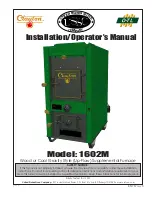
THE SHAVER OUTDOOR WOODBURNING FURNACE
How does an outdoor furnace heat my home?
The Shaver outdoor wood furnace is designed to save the most energy and provide the most
comfortable heating available. It heats your home by heating a firebox surrounded by a steel tank
filled with water. The furnace is basically a safe non-pressurized boiler with an atmospheric vent.
This hot water is then circulated through underground hot water pipes (Pex Pipe) to a water coil
(heat exchanger) installed inside your existing central duct system.
If you have a boiler, a water-to-water heat exchanger is used. The Shaver furnace can be
connected to virtually any existing pressurized or non-pressurized boiler, Hydronic or radiant
heating system that operates at 180 degrees or less. It will not work with steam systems.
How does the SHAVER furnace heat water for household use?
Water is circulated directly between your hot water heater and the outdoor furnace, through the
built in heat exchanger in our furnace. The water going back to your hot water heater is
preheated by a coil in the outdoor furnace. The only energy required is maintaining the hot water
temperature in the outdoor furnace. An extra circulating pump is needed. Page 35
A stainless steel shell and tube heat exchanger should be used for heating pools and spas. The
chlorine will tear up a brazed plate heat exchanger. See page 37
How do the Thermostat Controls work?
The only visible addition to the heating system inside your home is a 2nd thermostat, which is
located near the existing thermostat, if possible. The thermostat is installed (see page 32) so that
it turns the turns the blower on inside your existing furnace to force air across the hot water coil
(heat exchanger). This forces hot air into your central duct system. The original wall thermostat
turns on your original furnace, if the outside wood furnace is not in operation. Your existing
furnace will automatically take over to maintain your household temperature.
When the indoor furnace fan powers up, it sends power to the circulating pump, in the outdoor
furnace, to circulate the hot water through the heat exchanger.
If you have an existing boiler, the pumps are controlled by the thermostat. When the pump
comes on (assuming one main pump), power is sent to the outdoor furnace’s pump so that both
pumps run simultaneously.
Simply wire the outdoor furnace’s circulating pump to the power wire of the indoor pump (if using
a single pump). If you are using a controller for multiple pumps and zones but don’t have one
main pump, you will need to use your controller to turn on the outside pump anytime a pump in
A typical water-to-air heat exchanger - much like a small
radiator or heater core in a car, is installed in your ductwork.
When air blows through it, heat is extracted and hot air blows
out of your vents. You can also use hydronic or radiant heat
utilizing Pex Pipe under he floors or in a concrete floors or by
using radiators or baseboard hydronic heaters.
12













































